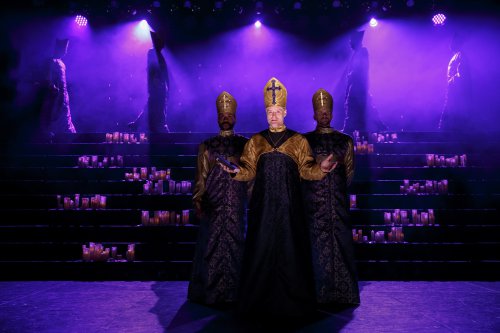Joan of Arc: Into the Fire
Disappointing follow-up to David Byrne and Alex Timbers’ “Here Lies Love” gives a fine Jo Lampert little to do in the title role.

Jo Lampert in a scene from “Joan of Arc: Into the Fire” (Photo credit: Joan Marcus)
[avatar user=”Victor Gluck” size=”96″ align=”left” ] Victor Gluck, Editor-in-Chief[/avatar]Composer-lyricist David Byrne and director Alex Timbers’ second biographical musical following their innovative and unique Here Lies Love is a disappointment and not only because of the tremendous success of their earlier collaboration. Joan of Arc: Into the Fire tells a story that has already been powerfully dramatized by such theater artists as George Bernard Shaw, Maxwell Anderson, Paul Claudel and Arthur Honegger, Friedrich Schiller and Peter Ilyich Tchaikovsky among others in the past.
Here the new rock opera is childish and simplistic giving Joan a rather thin and mundane life. With only a handful of defined characters, this becomes Joan’s story but she never seems to mature from the 16-year-old girl she was when we met her at the beginning of the tale. Too much of the show is just more of the same making this 95 minute musical seem overly long. Unlike Andrew Lloyd Webber and Tim Rice’s Jesus Christ Superstar, this never seems to have a new take on a well-known story.
Don’t blame singer Jo Lampert who gives a passionate performance as the Maid of Orleans. Unfortunately, she hasn’t been given anything very interesting to sing in this mostly sung-through musical. Her lyrics are trite and repetitious. She may have been a teenager, but there is no reason to have written lyrics that continue to sound like they were written by a junior high school student attempting his or her first songs. The endlessly repeated refrains do not serve to make Joan seem more simple and holy but sound like a lack of imagination. The minimal spoken dialogue is used for the various narrators and the trial testimony taken from the actual transcript of the event.
Beginning in the present with contemporary clothing and then flashing back to Medieval France, Joan of Arc: Into the Fire tells the story of the girl from Domrémy who in 1428 at the age of 16 heard voices that told her to go to the Dauphin, the uncrowned king of France, and ask for an army to defeat the English invaders. Passing a series of tests he puts in her way, he gives her what she asks and she conquers enough of France that he is able to be crowned in the cathedral of Reims.

James Brown III, Sean Allan Krill and Adam Perry in a scene from “Joan of Arc: Into the Fire” (Photo credit: Joan Marcus)
However, when she asks for more soldiers to finish the fight, he gives her only five hundred which is not enough to complete the job properly. Not surprisingly she is captured and the now King Charles of France does not have the money to ransom her. Put on trial by an ecclesiastical English court, she is offered a pardon if she recants and condemns her voices. Finally worn down, Joan signs a confession but is told that she will spend her life in prison. At this point, Joan takes back her recantation and is told she will be burnt at the stake. Twenty-four years later her mother Isabelle requests a retrial and the verdict is reversed. The cast returns to contemporary clothing for this final scene.
When the audience enters the theater, the show curtain proclaims: “She was warned. She was given an explanation. Nevertheless, she persisted.” This recent statement from Senate Majority Leader Mitch McConnell, a retort to Senator Elizabeth Warren, is an attempt to give the musical modern relevance just as the English general’s statement to the captured Joan, “We have ways of dealing with terrorists.” However, these current sentiments stick out like sore thumbs rather than draw any modern parallels. How does one give a saint from fifteen hundred years ago modern pertinence? Joan of Arc: Into the Fire doesn’t have a clue.
Unlike Byrne’s Here Lies Love which worked partly because of its very specific references and details, the songs in the new musical have generic titles like “A Prayer for Everyone,” “I Believe” and “A Glorious Day.” But they also have clichéd, repeated lines like “We need to help the human being,” “You are so beautiful,” “Send her to Heaven,” and “Have faith, be strong” which are less effective the more they are sung. “Have faith, be strong” is repeated so often that it appears to be Joan’s mantra, though it does not appear to save her. Many of the lyrics contain false rhymes which become very distracting once you notice them, particularly from a longtime songwriter like Byrne: tides/lives; king/things; fraud/God; breasts/flesh; gone/homes; mercy/worthy; throne/done, etc. The loud orchestrations are heavy on the electric guitars, the drums and the trumpet, none of which suggests Medieval France.
Ironically, the entire evening is stolen by veteran actress Mare Winningham who appears only in the final scene as Isabelle, Joan’s mother. Singing a low-key number with minimal musical accompaniment, she is more moving and effective than all the noise and tumult that has gone before. Aside from Lampert and Winningham who only play one role each, the ten-man ensemble plays various characters as well as all playing the French and English soldiers. However, most of them have little to do.

Jo Lampert and Michael James Shaw in a scene from “Joan of Arc: Into the Fire” (Photo credit: Joan Marcus)
Michael James Shaw’s Captain Baudricourt is a stalwart soldier but he disappears early in the story. As The Dauphin of France, Kyle Selig is devious and ambitious in his three short scenes. As his advisor La Tremouille, Mike McGowan is cunning and disdainful in the very brief time in which we see him. Most present is Sean Allen Krill as the politic and wily Bishop Cauchon who engineers Joan’s fate. Terence Archie’s Earl of Warwick doesn’t appear often enough to make much of an impression.
Timbers’ direction, usually so original and inventive, is here rather conventional and tame. The most effective scene is one in which the male ensemble play both French and then English soldiers which surprises us by having one costume on the front and another on their backs in Clint Ramos’ unusual and witty design. Aside from his rather modernistic costumes for Joan, the rest of the outfits for the soldiers, priests and courtiers are what you would expect for a contemporary rock opera. Christopher Barreca’s black unit set which continually breaks apart to create various locales is serviceable without being visually interesting or attractive. Much of the work is performed by the projection designs by Darrel Maloney on a huge screen above the set. Justin Townsend’s lighting is the most effective production element. Various moments are the work of special effects designer Jeremy Chernick.
There may be a terrific rock opera in the story of Joan of Lorraine but the new David Byrne musical isn’t it. More’s the pity as his last foray in musical theater was the unforgettable Here Lies Love. In what may be her largest theatrical role to date in New York City, Jo Lampert makes a strong impression in the title role even with mediocre songs. It would be fascinating to see what she can do with more vivid and higher quality material.
Joan of Arc: Into the Fire (through April 30, 2017)
The Public Theater
Newman Theater, 425 Lafayette Street, in Manhattan
For tickets, call 212-967-7555 or visit http://www.publictheater.org
Running time: 95 minutes with no intermission






Leave a comment